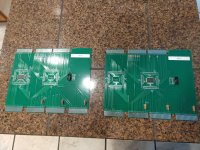thunter0512
Veteran Member
As this subject has come up a few times in other threads I have created a new thread just for this.
What would be the interest for a new PDP-8/e/m/f "Extendend Arithmetic Element" (EAE aka KE8E) board set re-implemented using currently available TTL ICs?
Roland Huisman has done similar work for the VR-14 display controller VC8E board set (M885R and M869R), mains-RTC (M882R), Floppy Controller RX8E (M8357R), and TA8E cassette tape controller (M8331R).
Tom
What would be the interest for a new PDP-8/e/m/f "Extendend Arithmetic Element" (EAE aka KE8E) board set re-implemented using currently available TTL ICs?
Roland Huisman has done similar work for the VR-14 display controller VC8E board set (M885R and M869R), mains-RTC (M882R), Floppy Controller RX8E (M8357R), and TA8E cassette tape controller (M8331R).
Tom

